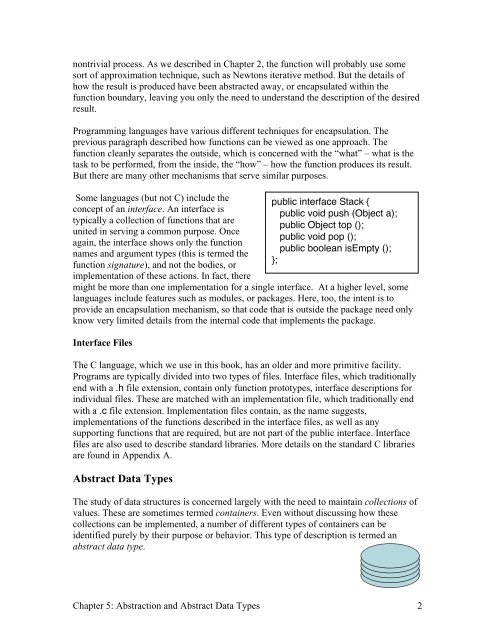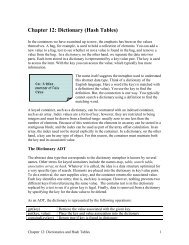Chapter 5: Abstraction and Abstract Data Types - Classes
Chapter 5: Abstraction and Abstract Data Types - Classes
Chapter 5: Abstraction and Abstract Data Types - Classes
You also want an ePaper? Increase the reach of your titles
YUMPU automatically turns print PDFs into web optimized ePapers that Google loves.
nontrivial process. As we described in <strong>Chapter</strong> 2, the function will probably use some<br />
sort of approximation technique, such as Newtons iterative method. But the details of<br />
how the result is produced have been abstracted away, or encapsulated within the<br />
function boundary, leaving you only the need to underst<strong>and</strong> the description of the desired<br />
result.<br />
Programming languages have various different techniques for encapsulation. The<br />
previous paragraph described how functions can be viewed as one approach. The<br />
function cleanly separates the outside, which is concerned with the “what” – what is the<br />
task to be performed, from the inside, the “how” – how the function produces its result.<br />
But there are many other mechanisms that serve similar purposes.<br />
Some languages (but not C) include the<br />
concept of an interface. An interface is<br />
typically a collection of functions that are<br />
united in serving a common purpose. Once<br />
again, the interface shows only the function<br />
names <strong>and</strong> argument types (this is termed the<br />
function signature), <strong>and</strong> not the bodies, or<br />
implementation of these actions. In fact, there<br />
might be more than one implementation for a single interface. At a higher level, some<br />
languages include features such as modules, or packages. Here, too, the intent is to<br />
provide an encapsulation mechanism, so that code that is outside the package need only<br />
know very limited details from the internal code that implements the package.<br />
Interface Files<br />
The C language, which we use in this book, has an older <strong>and</strong> more primitive facility.<br />
Programs are typically divided into two types of files. Interface files, which traditionally<br />
end with a .h file extension, contain only function prototypes, interface descriptions for<br />
individual files. These are matched with an implementation file, which traditionally end<br />
with a .c file extension. Implementation files contain, as the name suggests,<br />
implementations of the functions described in the interface files, as well as any<br />
supporting functions that are required, but are not part of the public interface. Interface<br />
files are also used to describe st<strong>and</strong>ard libraries. More details on the st<strong>and</strong>ard C libraries<br />
are found in Appendix A.<br />
<strong>Abstract</strong> <strong>Data</strong> <strong>Types</strong><br />
public interface Stack {<br />
public void push (Object a);<br />
public Object top ();<br />
public void pop ();<br />
public boolean isEmpty ();<br />
};<br />
The study of data structures is concerned largely with the need to maintain collections of<br />
values. These are sometimes termed containers. Even without discussing how these<br />
collections can be implemented, a number of different types of containers can be<br />
identified purely by their purpose or behavior. This type of description is termed an<br />
abstract data type.<br />
<strong>Chapter</strong> 5: <strong><strong>Abstract</strong>ion</strong> <strong>and</strong> <strong>Abstract</strong> <strong>Data</strong> <strong>Types</strong> 2

















